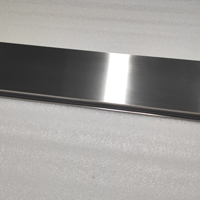Before some customers have consulted about titanium alloy, and they think that titanium alloy processing is particularly troublesome. Now, colleagues from RSM Technology Department will share with you why we think titanium alloy is a difficult material to process? Because of the lack of deep understanding of its processing mechanism and phenomenon.
1. Physical phenomena of titanium processing
The cutting force of titanium alloy is only slightly higher than that of steel with the same hardness, but the physical phenomenon of titanium alloy processing is much more complex than that of steel processing, which makes titanium alloy processing face great difficulties.
The thermal conductivity of most titanium alloys is very low, only 1/7 of steel and 1/16 of aluminum. Therefore, the heat generated in the process of cutting titanium alloy will not be quickly transferred to the workpiece or taken away by the chips, but will be concentrated in the cutting area, and the generated temperature can be as high as 1000 ℃ or above, so that the cutting edge of the tool can rapidly wear, crack and generate chip accretion tumors. The rapidly worn cutting edge can also generate more heat in the cutting area, further shortening the tool life.
The high temperature produced in the cutting process also destroys the surface integrity of titanium alloy parts, leading to the decline of geometric accuracy of parts and the emergence of work hardening phenomenon that seriously reduces their fatigue strength.
The elasticity of titanium alloy may be beneficial to the performance of parts, but in the cutting process, the elastic deformation of the workpiece is an important reason for vibration. The cutting pressure makes the “elastic” workpiece separate from the tool and rebound, so that the friction between the tool and the workpiece is greater than the cutting effect. The friction process also generates heat, which aggravates the poor thermal conductivity of titanium alloys.
This problem becomes more and more serious when machining thin-walled or ring shaped parts that are easily deformed. It is not easy to machine thin-walled titanium alloy parts to the expected dimensional accuracy. As the workpiece material is pushed away by the tool, the local deformation of the thin wall has exceeded the elastic range and plastic deformation occurs, and the material strength and hardness at the cutting point increase significantly. At this time, the cutting speed originally determined will become too high, further causing sharp tool wear.
”Heat” is the “culprit” of titanium alloy difficult to process!
2. Process tips for processing titanium alloy
On the basis of understanding the processing mechanism of titanium alloy, combined with previous experience, the main technological know-how for processing titanium alloy is as follows:
(1) The blade with positive angle geometry is used to reduce cutting force, cutting heat and workpiece deformation.
(2) Maintain stable feeding to avoid hardening of the workpiece. The tool shall always be in the feeding state during the cutting process. The radial cutting amount a e during milling shall be 30% of the radius.
(3) High pressure and large flow cutting fluid is used to ensure the thermal stability of the machining process, and avoid the surface deterioration of the workpiece and tool damage due to excessive temperature.
(4) Keep the blade sharp. The blunt tool is the cause of heat accumulation and wear, which simply leads to tool failure.
(5) As far as possible, it should be processed in the soft state of titanium alloy. As the material becomes more difficult to process after hardening, heat treatment improves the strength of the material and increases the wear of the blade.
(6) Use a large tool tip arc radius or chamfer to cut in, and put as many blades into the cutting as possible. This can reduce the cutting force and heat at each point and avoid local damage. When milling titanium alloy, the cutting speed has a great influence on the tool life vc, followed by the radial cutting (milling depth) ae.
3. Handle titanium processing problems from the blade
The groove wear of the blade during titanium alloy processing is the local wear of the back and front along the cutting depth, which is often caused by the hardening layer left by the previous processing. The chemical reaction and diffusion of tool and workpiece material at the processing temperature of more than 800 ℃ is also one of the reasons for the formation of groove wear. As titanium molecules of the workpiece accumulate in front of the blade during processing, they are “welded” to the blade under high pressure and high temperature, forming a chip buildup tumor. When the built-up chip is peeled off from the blade, the cemented carbide coating of the blade is taken away. Therefore, titanium alloy processing requires special blade materials and geometric shapes.
Post time: Sep-27-2022






